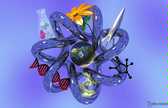

Challenge Based Learning. Workshop_guide3. TalkScience_Primer. Ohio Resource Center > Home. The Inquiry Project. Strategies to Support Mathematical Thinking. Whenever I take a new teacher to observe a veteran teacher, I’m surprised at what they notice.
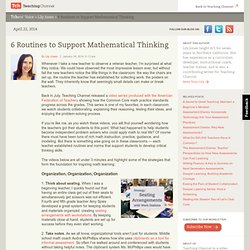
We could have observed the most impressive lesson ever, but without fail the new teachers notice the little things in the classroom: the way the chairs are set up, the routine the teacher has established for collecting work, the posters on the wall. They inherently know that seemingly small details can make or break teachers. Back in July, Teaching Channel released a video series produced with the American Federation of Teachers showing how the Common Core math practice standards progress across the grades. Overcoming Ecological Misconceptions - Self Test. Teacher Education Materials Project (TE-MAT) : A Database for K-12 Professional Development Providers. Formative assessment. Teacher Tom. JCE Online: CQs and ChPs: CQs: Chemical Concepts Inventory.
The Chemical Concepts Inventory* (CCI) is a multiple choice instrument that can be used to indicate the level of chemistry misconceptions held by students.
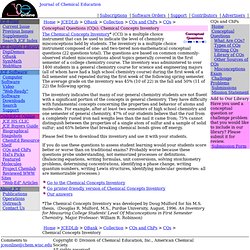
The inventory is a multiple choice instrument composed of one- and two-tiered non-mathematical conceptual questions (22 questions total). The questions are based on common commonly-observed student misconceptions about topics generally covered in the first semester of a college chemistry course. The inventory was administered to over 1400 students in a general chemistry course for science and engineering majors (all of whom have had a high school chemistry course) during the first week of a fall semester and repeated during the first week of the following spring semester. The average grade on the inventory was 45% (10 of 22) in the fall and 50% (11 of 22) the following spring.
CL-1: Field-tested Learning Assessment Guide (FLAG): Tools. Bioliteracy Project Home Page. Publications and resources. Leadership Development and Training - Fierce, Inc. Cindy Huggett. A big ‘thank you’ to everyone who attended last week’s session: “3 Simple Steps to Convert Classroom Training to Online Training.”

Webinars. Sept. 25 - Vivian Elliott & Mark Wilding host "The Five Dimensions of Engaged Teaching" CHECK THE FULL SCHEDULE AND REGISTER NOW!
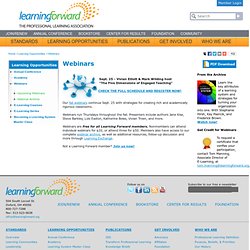
Our fall webinars continue Sept. 25 with strategies for creating rich and academically rigorous classrooms. Webinars run Thursdays throughout the fall. Presenters include authors Jane Kise, Steve Barkley, Lois Easton, Katherine Boles, Vivian Troen, and more. Webinars are free for all Learning Forward members. Nonmembers can attend individual webinars for $20, or attend three for $50.
news.citrixonline.com/wp-content/uploads/2013/09/Leading-Geeks_Citrix_white-paper_4-Steps-to-Transforming-Dysfunctional-Teams.pdf. Convert Classroom Training to Virtual Training in Three Simple Steps. www.cindyhuggett.com/wp-content/uploads/2012/10/Behind-the-Scenes-Handout.pdf. www.cindyhuggett.com/wp-content/uploads/2013/05/5-TECHNIQUES-to-DELIVER.pdf. www.cindyhuggett.com/wp-content/uploads/2013/05/5-TECHNIQUES-to-DELIVER.pdf. www.cindyhuggett.com/wp-content/uploads/2013/05/5-TECHNIQUES-to-DESIGN.pdf. www.cindyhuggett.com/wp-content/uploads/2012/04/VirtualActivitySelectionGrid_fromASTDInfoLine2.pdf. ZooTeach. Engage: Watch Shift Happens: 67 slides (8 min) * The lesson will begin by watching the “shift happens” slide show which will introduce information the students may not be aware of and should raise questions about what this globalization of information means to their lives.
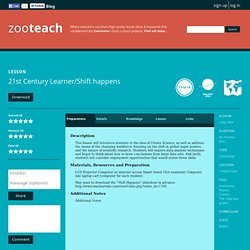
Discussion: “Our changing world” * The class will write down ideas and Questions that re brought up during the discussion. These lists will remain posted in the room through the duration of the lesson. Explore: Introduce Citizen Science- Discuss the fact that scientists now are obtaining enormous data sets that are too large to be analyzed by individual scientists. Science K-2. Can You Make Light Change Direction?

In groups of two, you will explore and investigate the materials available to find ways to make light change direction. First, place the target at least 3 feet away. Then, use your flashlight to shine light into the mirrors to see if you can change the direction of the light so that it reaches your target. The light cannot travel directly to the target. It must hit at least 2 mirrors first.
Grade Level Big Ideas and Unifying Concepts. Inquiry Based Science Lesson Plans. Exemplars inquiry-based investigations provide teachers and administrators with a way of teaching and assessing science-process and communication skills.

Our performance tasks are classroom tested and can be used for assessment, instruction and/or professional development. Investigations have been reviewed and approved by NSTA Recommends. Science material features: A Common Core “Must Read” Paper. NH Field Investigation Models. Using Field Investigations to Model Scientific Inquiry State and national science standards emphasize the importance of inquiry and problem-solving for today’s students.
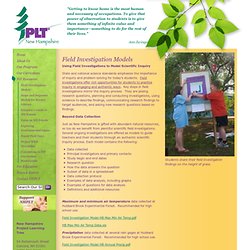
Field investigations offer rich opportunities for students to practice inquiry in engaging and authentic ways. Key steps in field investigations mirror the inquiry process. They are posing research questions, planning and conducting investigations, using evidence to describe findings, communicating research findings to target audiences, and asking new research questions based on findings. Beyond Data Collection. Online Stopwatch. World Games - Running Timer. Rocket Timer - Online Stowpatch. World Games - Swimming Timer. Dropout Indicators Found for 1st Graders. The_Productivity_Handbook.pdf. The Voice of Fish & Wildlife Agencies: North American Conservation Education Toolkit.
The Voice of Fish & Wildlife Agencies Focus Areas The North American Conservation Education Strategy: A Tool Kit for Achieving Excellence The Conservation Education Strategy Tool Kit contains resources developed by the Association of Fish and Wildlife Agencies (AFWA) to support conservation educators who offer fish and wildlife based programs.
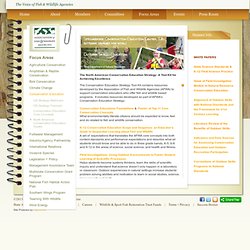
It includes resources developed as part of AFWA’s Conservation Education Strategy: Conservation Educations Foundations & Poster of Top 11 Core Conservation ConceptsWhat environmentally literate citizens should be expected to know, feel and do related to fish and wildlife conservation. Field Investigations: Using Outdoor Environments to Foster Student Learning of Scientific ProcessesHelps students become systems thinkers, learn the skills of scientific inquiry and understand that science doesn’t only happen in a laboratory or classroom.
ConEd-Field-Investigations-Guide.pdf. Articles. K12 Online Conference. Exploring Oceans. Classes should do hands-on exercises before reading and video, Stanford researchers say. July 16, 2013 A study from the Stanford Graduate School of Education of how students best learned a neuroscience lesson showed a distinct benefit to starting out by working with an interactive 3D model of the brain.
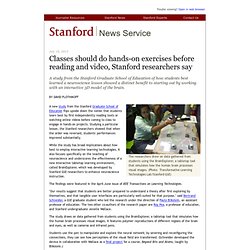
By David Plotnikoff The researchers drew on data gathered from students using the BrainExplorer, a tabletop tool that simulates how the human brain processes visual images. (Photo: Transformative Learning Technologies Lab/Stanford GSE) A new study from the Stanford Graduate School of Education flips upside down the notion that students learn best by first independently reading texts or watching online videos before coming to class to engage in hands-on projects. Leadership 3.0. Innovative PD Resources. Org · National Geographic Great Nature Project. 4 Ways to Make a Good Impression in Online Classes. Charles Belote, an online bachelor's student from Amarillo, Texas, says he sees his fair share of bad behavior on the online discussion boards he is required to use for class.
In one online course he took at Colorado State University—Global Campus, he saw students use a class discussion board to gang up on a student from Mexico who struggled with English. In others, his classmates used bad grammar and poor spelling during their required online debates. Decades ago, the only way students could express themselves in class was to raise a hand and join the discussion. I.C.E. = Investigating, Creating, Exploring. AAAS on Education. INTRODUCTION—In this special issue of Science, we have invited experts to tell us what they think are the most important challenges facing science education. Through a mixture of News, Reviews, Perspectives, Education Forums, and an Editorial, we explore the obstacles to progress, be they within the classroom, across the school system, or in the larger social arena.
We also offer substantive suggestions on how to proceed. For example, distance education, online simulations as educational aids, and social networking tools are already part of science education. Many university faculty members are working to upgrade centuries-old approaches to instruction. And, with a new emphasis on the practice of science, promising assessment tools are being developed to improve learning. NGSS Designed for Wide Range of Learners. Harvard STEM Teaching Videos. Posted on May 28th, 2013 by Mary Lord Looking for a way to make probability come to life in your multicultural math class and assess which students “got it?” How about a fun activity that gives high-school students a hands-on feel for fundamental calculus concepts and also meets state content standards? The Harvard-Smithsonian Center for for Astrophysics has compiled a digital video library full of curriculum-enhancing lessons, assessment tools, and case studies - all developed and used by teachers in their classrooms.
These “Videos to Enhance Understanding and Teaching of K-12 Learning Goals,” as the project is called, feature: • Clinical Interviews of Student Ideas • Demonstrations of Phenomena • Case Studies of Instruction or Research • Interviews with Experts • Correlations to state and national curriculum standards. Metryx. Global STEMx Education Conference. Conference 2.0 - Web 2.0 Labs. Assessment Instrument Information Page.
Assessment Instrument Information Page. Operation Physics: Children's science misconceptions. How To Make Sure Professional Development Is Not An Oxymoron. I have always contended that the term “Professional Development” is an oxymoron for most educators. Let’s face it, most people do not look forward to Professional Development (PD) Days in their school district due to the fact that most of these are created with someone else deciding what is most important for the learners.
Make PD More Effective. “One goal of a staff meeting is to get teachers excited about teaching the next day.” Growth Hurts: Create Positive Discomfort. Growth hurts. Doubt and stress describe growth points. 4 Steps for Supporting Professionals. The following guest blog post was written by PJ Caposey , author of Eye On Education's upcoming book Building a Culture of Support: Strategies for School Leaders , publishing in November, 2012. PJ is the principal of Oregon High School, an adjunct professor in the educational leadership department for Aurora University, and he is currently pursuing his Doctoral degree through Western Illinois University. Powerful Designs for Team Learning. Facilitated by Lois Brown Easton Play this webinar.
Author and Learning Forward senior consultant Lois Brown Easton leads a discussion focused on implementing powerful team learning strategies. This webinar explores the crucial needs of teams that engage in the work of improving schools. Get Hesitant Teachers to Use Technology. In my consulting as well as administrative technology work, I am often asked the same questions by different schools and officials.
Convincing Reluctant Teachers. 5 Ways To Support Teachers Skeptical Of Technology. For some, the technology rich classroom is easy to justify. Once you have made the transition and seen the benefits, it is easy to weigh them against the potential risks and worries about the problems resulting from having a room full of devices. For these “dive right in” types, the process makes a lot of sense. iTeach Blog.